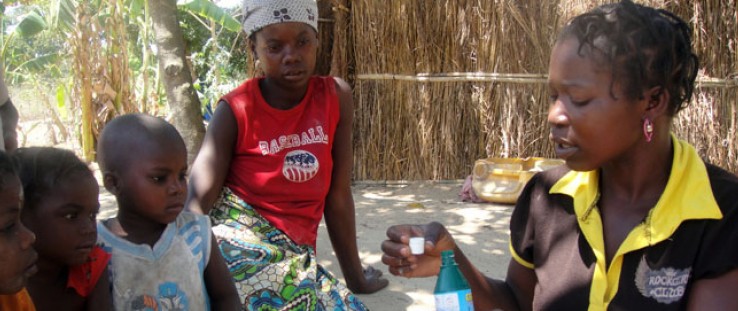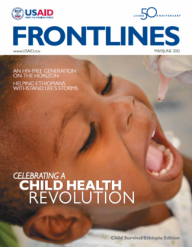 Community health worker Rosalina Casimiro meets with children in Nampula province, Mozambique, to demonstrate how to purify water prior to drinking.
Luisa Chadreque, Pathfinder Nampula
Community health worker Rosalina Casimiro meets with children in Nampula province, Mozambique, to demonstrate how to purify water prior to drinking.
Luisa Chadreque, Pathfinder Nampula
 Community health worker Rosalina Casimiro meets with children in Nampula province, Mozambique, to demonstrate how to purify water prior to drinking.
Luisa Chadreque, Pathfinder Nampula
Community health worker Rosalina Casimiro meets with children in Nampula province, Mozambique, to demonstrate how to purify water prior to drinking.
Luisa Chadreque, Pathfinder Nampula
Health Worker Article Series
Madagascar: Keeping Mothers Safe to Be Mothers
Kenya: Support from Clinic to Hospital to Home
Zambia: Coordinating Roles and Connecting with Care
Mozambique: Strength in Community Care
Bangladesh: Family Planning for Healthier Futures
Timor-Leste: Walking Together on the Long Road to Health
Front-line health workers are the first and often the only link to health care for millions of children in the developing world. They are the most immediate and cost-effective way to save lives, and foster a healthier, safer and more prosperous world. The developing world has experienced remarkable declines in maternal, child and infant mortality in recent decades, thanks in large part to the contributions of those who bring the most basic health services and education into the communities of the world’s underserved.
Millions of people are alive today because a midwife was by their side when they gave birth, or they were vaccinated as infants by a nurse, or because their families learned from a community health worker to adopt healthy behaviors like breastfeeding, hand washing, birth spacing and sleeping under a mosquito net.
While progress is being made thanks to the training and deployment of health workers in many countries, there are still too few health workers to reach the millions of families who urgently need care. Millions of children still die every year from preventable causes. The World Health Organization estimates a shortage of at least 1 million front-line health workers, particularly in Africa and parts of Asia.
A million more health workers could save many millions more if they had proper training and support.
Many of the interventions that have proven most effective in saving lives require health workers with some kind of training to deliver them. Front-line health workers do not need to be highly educated to be successful. Experience in many countries has shown that health workers with basic schooling plus several weeks of well-designed training, followed by on-the-job supervision, can master the skills needed to diagnose and treat common illnesses, promote lifesaving health practices, and counsel families about family planning, nutrition and hygiene.
Some front-line health workers are midwives, nurses or private providers such as drug-shop dispensers. Many are community health workers who are selected by—and working in—their own communities. To ensure acceptance of these health workers by their communities, they must respond to local norms and customs. Some front-line workers are compensated for their work, either through the formal health system or by the communities they serve; others are volunteers motivated by non-monetary incentives, including flashlights and bicycles, as well as a sense of pride in their work, and increased status in their communities. Many female front-line health workers, in particular, note that their role has helped increase the respect they get from their families, friends and neighbors.
Major killers of children such as diarrhea, pneumonia, malaria and newborn complications can often be prevented or treated close to home by a well-trained health worker who is armed with basic tools and skills, and is part of a functioning health system.
“For more than 40 years, USAID has helped children throughout the world grow into healthy, productive adults. Progress in child survival has long been, and remains among the Agency’s major accomplishments,” said USAID’s Deputy Assistant Administrator for Global Health Robert Clay.
USAID-funded initiatives save the lives of approximately 6 million children under 5 each year. The following stories from Madagascar, Kenya, Zambia, Mozambique, Bangladesh and Timor-Leste highlight some of the health workers who are saving lives in their communities, and individuals whose lives have been touched—through USAID support—by these saviors on the front lines.
Members of the Frontline Health Workers Coalition contributed to the articles in this special section.
How many die each year?
- 7.6 million children under 5 die every year, 3.1 million of them during their first month of life.
- Major causes of death among children are pneumonia, which causes 1.6 million 1.4 million deaths each year, and diarrhea, which causes 1.3 million 800,000 deaths each year. Malnutrition is estimated to contribute to more than one-third of deaths among children.









Comment
Make a general inquiry or suggest an improvement.